2 Developments in the beneficiary states and Norwegian interests
Today the EEA consists of 30 European countries. Most of the countries that receive support through the EEA and Norway Grants became members after the fall of communism. EU enlargement has made the EEA even more important to Norway and for Norwegian economic relations. Norway has extensive economic relations with Europe; over 80 % of our foreign trade is with the EEA countries. Economic and political stability in Europe is in all our interests. Today, however, several of the beneficiary states are suffering from the consequences of the financial crisis, which has led to slow economic growth and high unemployment.
There are considerable differences between the beneficiary states. This applies to the former East-bloc countries, although many of the challenges they face are similar. In the same way, the beneficiary states in southern Europe have individual differences but a number of challenges in common. Slovenia is so far the only country in the former Yugoslavia that is a member of the EU, but Croatia is expected to join on 1 July 2013.
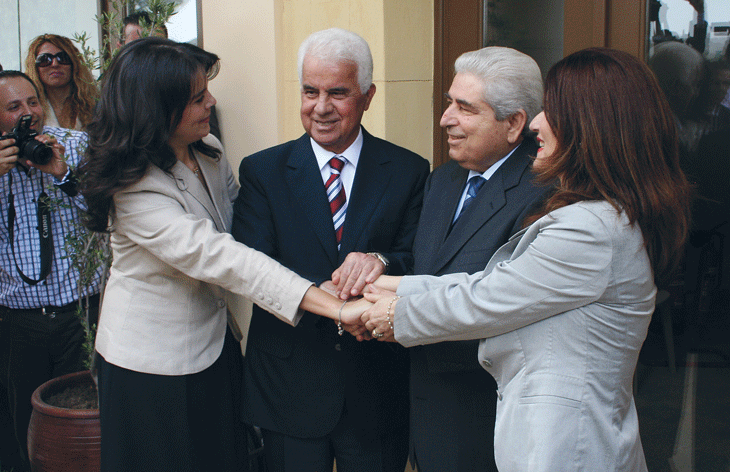
Figure 2.1 Both the President of Cyprus and the head of the Turkish Cypriot community attended the opening of the Home for Cooperation (H4C) in the UN buffer zone in Nicosia. The H4C, which is a unique meeting place for the two communities that inhabit the island, was built with financial support from the EEA and Norway Grants.
Photo: Ministry of Foreign Affairs
2.1 Fundamental changes in the Baltic and Central European countries1
The Baltic and the Central European countries have all undergone a series of difficult and rapid changes over the last 20 years. In just a few years, communist rule, a command economy and affiliation with COMECON, the Warsaw Pact, and the other international structures in the Soviet Union’s sphere of dominance, were replaced by democracy, a market economy and membership of European and transatlantic organisations like the EU and NATO.
These countries’ desire for membership of the EU and NATO has shaped their development since the mid-1990s. They have faced huge political and economic problems and have had to implement major reforms in order to fulfil the requirements for membership of these organisations. Some of them had regained their independence after the fall of communism and had to undertake a comprehensive process of state- and nation-building as well. This said, the Baltic and Central European countries have undergone an impressive reform and development process. Today they are members of the EU, NATO and other international organisations for which democratic governance and a market economy are requirements. However, this does not mean that all the reforms have been completed.
2.2 Economic challenges
The Baltic and Central European countries became members of the EU in 2004. For the first few years they experienced strong economic growth, and some of them had a substantial increase in per capita GDP. The strong growth resulted in a marked increase in prosperity up to 2009. Per household income in the eight countries that became members in 2004 had been about half that of the EU average in 2000, but by 2009 it had risen to almost two-thirds. This positive trend was only broken when the financial crisis took effect.
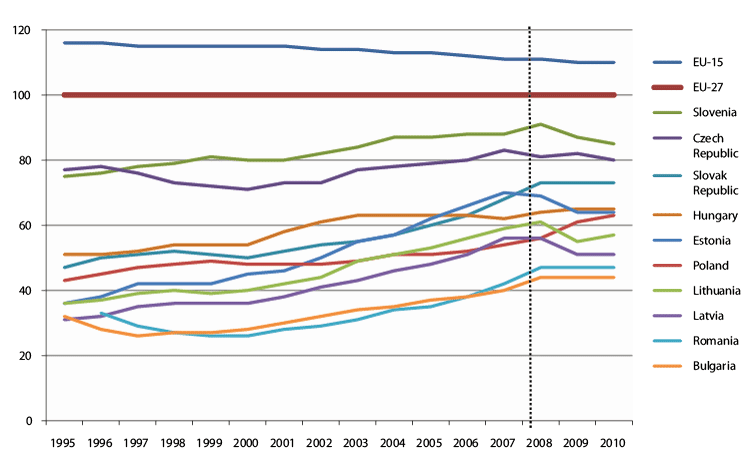
Figure 2.2 Per capita GDP in the Baltic and Central European countries in relation to the average in the EU countries (EU27)1
1 Based on Eurostat figures
The financial crisis hit the Baltic and Central European economies very hard in 2009, and in most of them GDP declined considerably. Most of these economies are open and relatively small, with a high level of foreign investment, which makes them vulnerable to international developments. They are also closely integrated into the European economy in various ways, for example through foreign ownership, debt and dependence on exports, and are therefore affected by developments in the European market. The financial crisis has also resulted in a marked increase in their government debts. This means that they have limited opportunities for addressing the economic downturn by introducing measures to stimulate the economy. The Central European countries are easily affected by problems in the European bank and finance institutions that have large ownership interests in their financial sectors. Productivity continues to be markedly below the EU average.2
The southern European countries3 have also been hard hit by the financial crisis. Greece was the first southern European country to negotiate a bailout package from the European Central Bank and the International Monetary Fund. In March the country received a new bailout package and the government debt to private creditors was written down. In 2011 Portugal was also forced to seek help, and Spain is now in serious difficulties. However, the problems are not the same in all of them. Greece is in a particularly difficult situation, and needs to strengthen its institutions, improve budget management and tax collection, and undertake comprehensive structural reforms. Portugal has similar problems to Greece, but a far better starting point for addressing them. In Spain public finances, the banking sector and the labour market are all facing serious problems. In all these countries the industrial sector has a high share of low-technology industries such as the manufacture of textiles and footwear, a type of production that is increasingly being taken over by emerging economies like China and India. The trends in labour costs in Greece, Portugal and Spain have not matched their rather moderate trends in productivity, which has resulted in a loss of competitiveness and large trade deficits. Low growth capability and high unemployment have made it difficult for these countries to solve their problems through economic growth, and it is crucial for them to undertake reforms that improve their growth capability.
Cyprus and Malta are small, vulnerable economies that are sensitive to international economic fluctuations. So far their debt situation is under control, but Cyprus is very vulnerable to the economic crisis in Greece. There are also large differences in the economy between the Republic of Cyprus and the Turkish Cypriot area in the north.
2.3 Social development
Table 2.1 United Nations Human Development Index 20111
Rank | Country | Index |
|---|---|---|
1 | Norway | 0.943 |
3 | Netherlands | 0.910 |
7 | Ireland | 0.908 |
8 | Liechtenstein | 0.905 |
9 | Germany | 0.905 |
10 | Sweden | 0.904 |
14 | Iceland | 0.898 |
16 | Denmark | 0.895 |
18 | Belgium | 0.886 |
19 | Austria | 0.885 |
20 | France | 0.884 |
21 | Slovenia | 0.884 |
22 | Finland | 0.882 |
23 | Spain | 0.878 |
24 | Italy | 0.874 |
25 | Luxemburg | 0.867 |
27 | Czech Republic | 0.865 |
28 | United Kingdom | 0.863 |
29 | Greece | 0.861 |
31 | Cyprus | 0.840 |
34 | Estonia | 0.835 |
35 | Slovak Republic | 0.834 |
36 | Malta | 0.832 |
38 | Hungary | 0.816 |
39 | Poland | 0.813 |
40 | Lithuania | 0.810 |
41 | Portugal | 0.809 |
43 | Latvia | 0.805 |
50 | Romania | 0.781 |
55 | Bulgaria | 0.771 |
1 The table shows the countries in order of performance (out of a total of 187 countries) and their score on a scale of 1 to 0.
The Baltic and Central European countries inherited the unwieldy, ineffective social welfare systems of the communist era. The tough restructuring processes that were carried out in the 1990s, with their welfare cuts,4 have resulted in many social challenges, and the situation has been aggravated by the financial crisis and subsequent high unemployment. Although general prosperity has increased considerably, wealth is unevenly distributed. This means that in these countries there are larger social groups particularly vulnerable to recession than there are in Western Europe. According to Eurostat’s definition,5 17.1 % of the population of the EU were in a vulnerable financial situation in 2009, while in the Baltic and Central European countries the proportion was much higher. However, there were large variations: the Czech Republic, Estonia and Slovenia were at about the same level as the EU average, while for the others the proportion varied from 24.5 % (the Slovak Republic) to 55.5 % (Bulgaria).
Since the Baltic and Central European countries joined the EU, many of their inhabitants have taken the opportunity to seek employment abroad, although the proportion of the population who consider emigrating is above the EU average only in the Baltic countries.6 Crime in the Baltic and Central European countries has in general declined since EU membership, but although the situation has improved there are still major challenges in the justice sector.
The southern European countries are marked by large income disparities and uneven growth. Social welfare payments such as social security and unemployment benefits are small, and the family constitutes an important social security network. Much of the work of relieving social distress is done by NGOs. The financial crisis has had serious consequences. Although cuts in the public sector and higher taxes are affecting groups at every social level, groups that were already vulnerable are being especially hard hit by the austerity measures. As the crisis develops, unemployment in the southern European countries is rising, with all that this entails. This is particularly evident in Spain, where unemployment is over 20 %. High youth unemployment is a problem in all the southern European countries, especially Spain. Increasing numbers of people in southern Europe are willing to emigrate in order to find jobs, especially the young and the well-qualified.
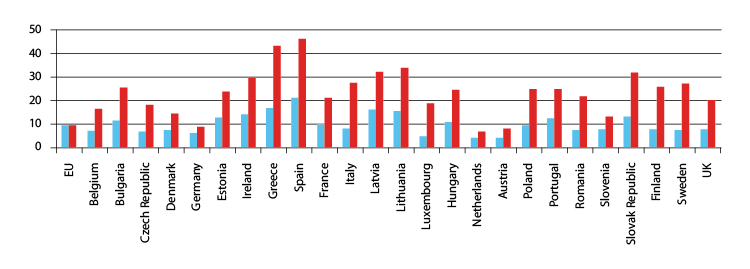
Figure 2.3 Unemployment in Europe, second quarter, 2011. Blue: 15–74 years, red: youth unemployment, 15–24 years.
Source Eurostat
2.4 Governance and political trends
While economic and social development in the Baltic and Central European countries is moving towards the EU average, the political trends are dissimilar. In several of these countries political life is marked by a high level of conflict, little consensus, a focus on personal conflicts in the public debate, a lack of transparency in political party funding, and a nebulous network of power relations, where political and economic interests are intertwined.
In some of these countries extreme right-wing nationalist movements and ethnic conflicts are increasing, and the Roma are a particularly vulnerable group.
It is important that civil society in these countries is further developed so that it can effectively promote democratic standards and serve as a corrective to parliamentary democracy and as an arena for broad public participation in political processes. One of the objectives of the EEA and Norway Grants is to support civil society in this role. NGOs in Central Europe are in a far more difficult financial situation than they were 10–15 years ago.
Corruption is a major challenge in many of the beneficiary states. Transparency International’s Corruption Perception Index shows negative trends for Bulgaria, Greece, Spain, Portugal and Hungary, although the trend is positive in the remaining countries.
Table 2.2 Transparency International’s Corruption Perception Index, ranking countries in terms of how corrupt their public sector is perceived to be1
2000 | 2011 | |||
|---|---|---|---|---|
Score | Rank | Score | Rank | |
Estonia | 5.7 | 27 | 6.4 | 29 |
Cyprus | - | - | 6.3 | 30 |
Spain | 7 | 22 | 6.2 | 31 |
Portugal | 6.3 | 25 | 6.1. | 32 |
Slovenia | 5.5 | 28 | 5.9 | 35 |
Malta | - | - | 5.6 | 39 |
Poland | 4.1 | 43 | 5.5 | 41 |
Lithuania | 4.1 | 43 | 4.8 | 50 |
Hungary | 5.2 | 32 | 4.6 | 54 |
Czech Republic | 4.3 | 42 | 4.4 | 57 |
Latvia | 3.4 | 57 | 4.2 | 61 |
Slovak Republic | 3.5 | 52 | 4.0 | 66 |
Romania | 2.9 | 68 | 3.6 | 75 |
Greece | 4.2 | 42 | 3.4 | 80 |
Bulgaria | 3.5 | 52 | 3.3 | 86 |
1 A score of 10 indicates that a country is perceived as very clean, while 0 indicates that a country is perceived as highly corrupt. A country's rank indicates its position relative to the other 181 countries in the index.
The new member states have established positions within the EU in different ways. During its EU Presidency, Poland established a position as an important actor in EU cooperation.
2.5 Norway’s relations with the beneficiary states
The liberation of the Baltic countries paved the way for a new neighbourhood policy for the Nordic countries, and new forms of cooperation were established. Today the Nordic and Baltic prime ministers meet once a year, and so do other ministers and the presidents of the various parliaments. In Norway the liberation of these countries was met with great interest and enthusiasm among the general public, with the active involvement of many local authorities. Today there is extensive contact between companies, artists and civil servants in the Nordic and Baltic countries. Nordic–Baltic cooperation also includes foreign policy consultations and practical cooperation in a number of areas. In the Council of the Baltic Sea States, which was established in 1992, Norway cooperates with the Baltic countries and Poland on environmental and climate change issues, human trafficking and international crime. The Council of Europe, which the Baltic and Central European countries joined in the first half of the 1990s, provides an important meeting place in which to discuss human rights, democracy and the principles of the rule of law. The same applies to the Organization for Security and Co-operation in Europe (OSCE). However, for all these countries the main foreign policy priority has been membership of NATO and the EU.
In 2001 Norway drew up an action plan for the 12 applicant countries to the EU, which was later expanded to include Romania and Bulgaria as well. The objective was twofold: to support the countries’ integration into the EU/EEA, and to strengthen their ties with Norway, with particular focus on our ties with the Baltic and Central European countries. Almost NOK 300 million was allocated to various measures towards these objectives. The action plan was a success, and in many of the countries it laid the foundation for further cooperation after they had become EU members. Today all the countries receive funding from the EEA and Norway Grants.
Trade between Norway and the Baltic and Central European countries has increased, and today they are important trading partners for Norway. Since they joined the EU in 2004 (Bulgaria and Romania in 2007), total Norwegian exports to these countries have risen from NOK 9.3 billion to NOK 24.6 billion in 2010. The percentage rise in Norwegian exports to the region was higher than that to the EU as a whole. These countries have also proved to be attractive export partners in times of economic crisis; Norwegian exports to the region were higher in 2011 than they had been before the financial crisis.
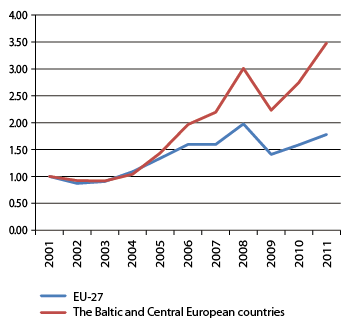
Figure 2.4 Norwegian exports to the EU and the Baltic and Central European countries in 2001–11 expressed as percentage changes from 2001.
Source Statistics Norway
Research cooperation between Norway and the Central European countries has increased steadily over the last 15–20 years. Norway has developed close cooperation with Poland especially, but contact has also increased with the Czech Republic and Hungary, measured in terms of co-publishing and cooperation under the EU Framework Programmes for Research and Technological Development. An evaluation has shown that the cooperation has not only strengthened Norway’s partners but also Norway itself. These countries have a strong academic tradition in fields that are valuable for Norway such as physics and mathematics. At the same time Norwegian research communities have made important contributions to projects in the natural sciences, for example by sharing Norway’s tradition of adopting a cross-disciplinary approach to research problems.
Several Central European countries have become popular places for Norwegian students wishing to take all or part of their degrees abroad. While the most popular countries for Norwegian students are still the UK, Denmark and the US, there has been a strong increase in the number of students in Poland, which rose from 380 in the academic year 2001–02 to 1 383 in 2010–11. Today Hungary and Slovak Republic also have many Norwegian students, most of whom are studying for the professions.
The number of students in Norway from the Baltic and Central European countries has also risen. The total number of foreign students to take a PhD in Norway doubled from 1990–99 to 2000–09, and over the same period the number of candidates from the Baltic and Central European countries increased tenfold; in 2010, 41 candidates from these countries took their PhDs at Norwegian higher education institutions.
Since the EU enlargement of 2004, immigration from the Baltic and Central European countries to Norway has increased substantially, mainly due to labour migration. Today Poles are the largest immigrant group, numbering around 60 000. In comparison, the next largest group, Swedes, numbers around 35 000, and Lithuanians around 16 000. These numbers do not include employees who are not registered as immigrants. At present most immigrants to Norway come from the new EU countries. Labour migration from these countries has contributed to the highest net immigration Norway has ever experienced. This has had positive effects on the Norwegian economy. Badly needed labour has become available, resulting in more people-to-people contact and increasing Norwegians’ interest in, attention to and knowledge of these countries.
The developments in the areas of trade, immigration, and cooperation in research and higher education show that the new EU members are becoming increasingly important to Norway. Poland and the Baltic countries are especially important because of their geographical proximity.
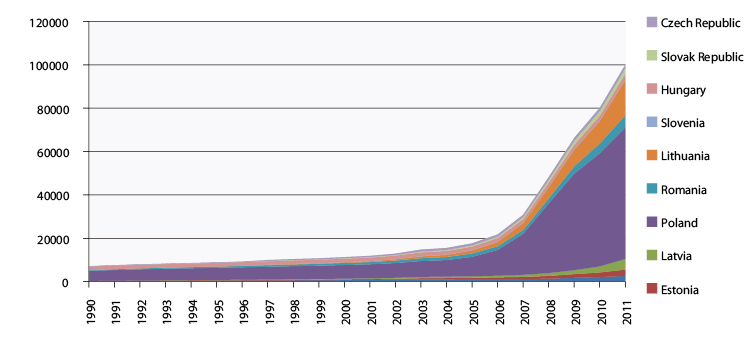
Figure 2.5 Immigration1 to Norway from the Baltic and Central European countries.
1 According to Statistics Norway’s definition: immigrants and Norwegian-born individuals with two immigrant parents.
Source Statistics Norway
Footnotes
Source: Eurostat. While the EU average for social protection was 26.4 % of GDP (Expenditure on Social Protection), the average for the 10 new member states in the Baltic and Central Europe was 17.1 %, and all of them were below the EU average.
Eurostat (Statistical Portraits of the Social Situation 2010) uses the term “material deprivation”, which is defined as an enforced lack of at least three of the nine following items: ability to meet unexpected expenses, ability to pay for a one-week annual holiday away from home, existence of arrears (mortgage or rent payments, utility bills, etc.), capacity to have a meal with meat, chicken or fish every second day, capacity to keep home adequately warm, and possession of a washing machine, a colour TV, a telephone or a personal car.